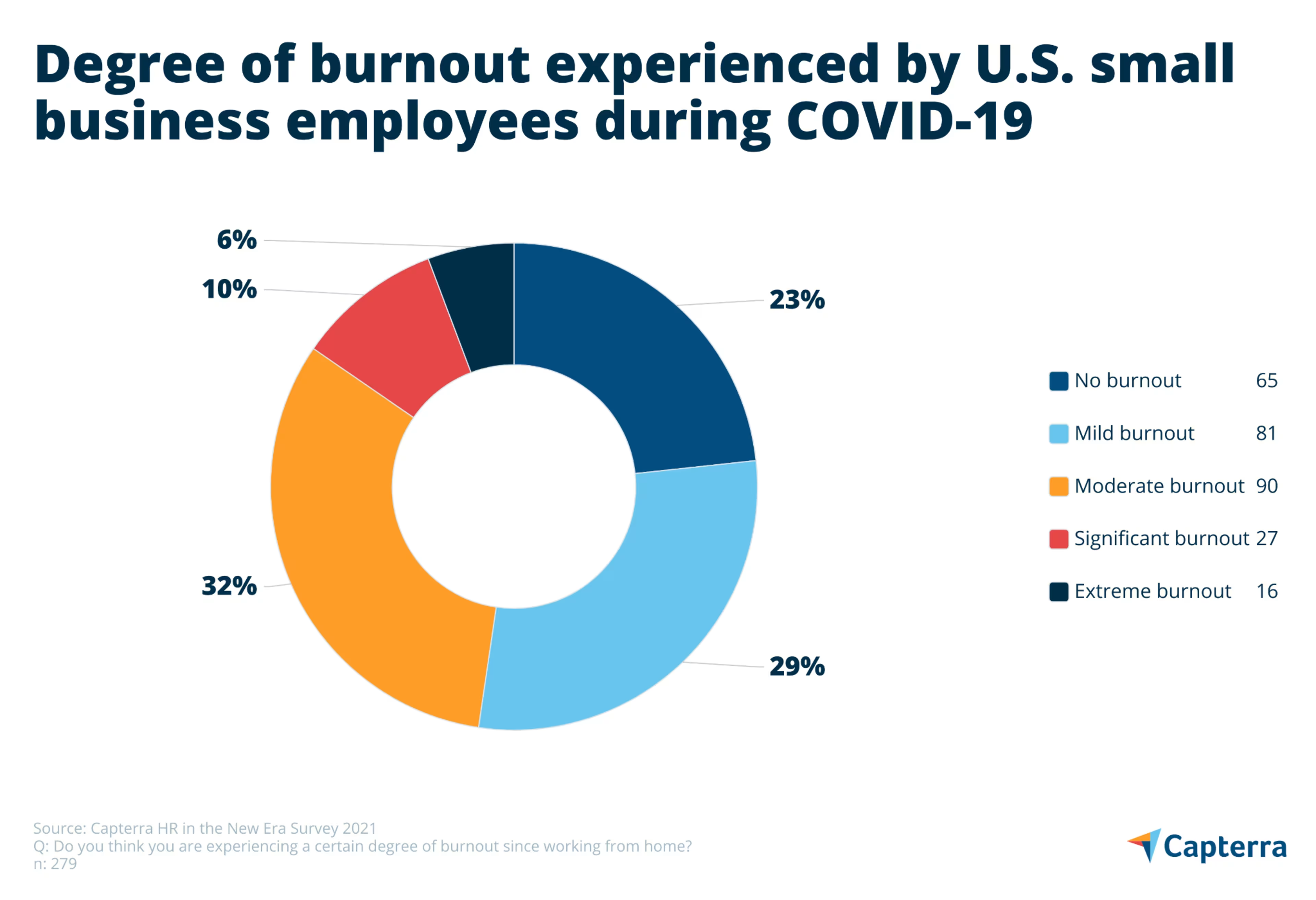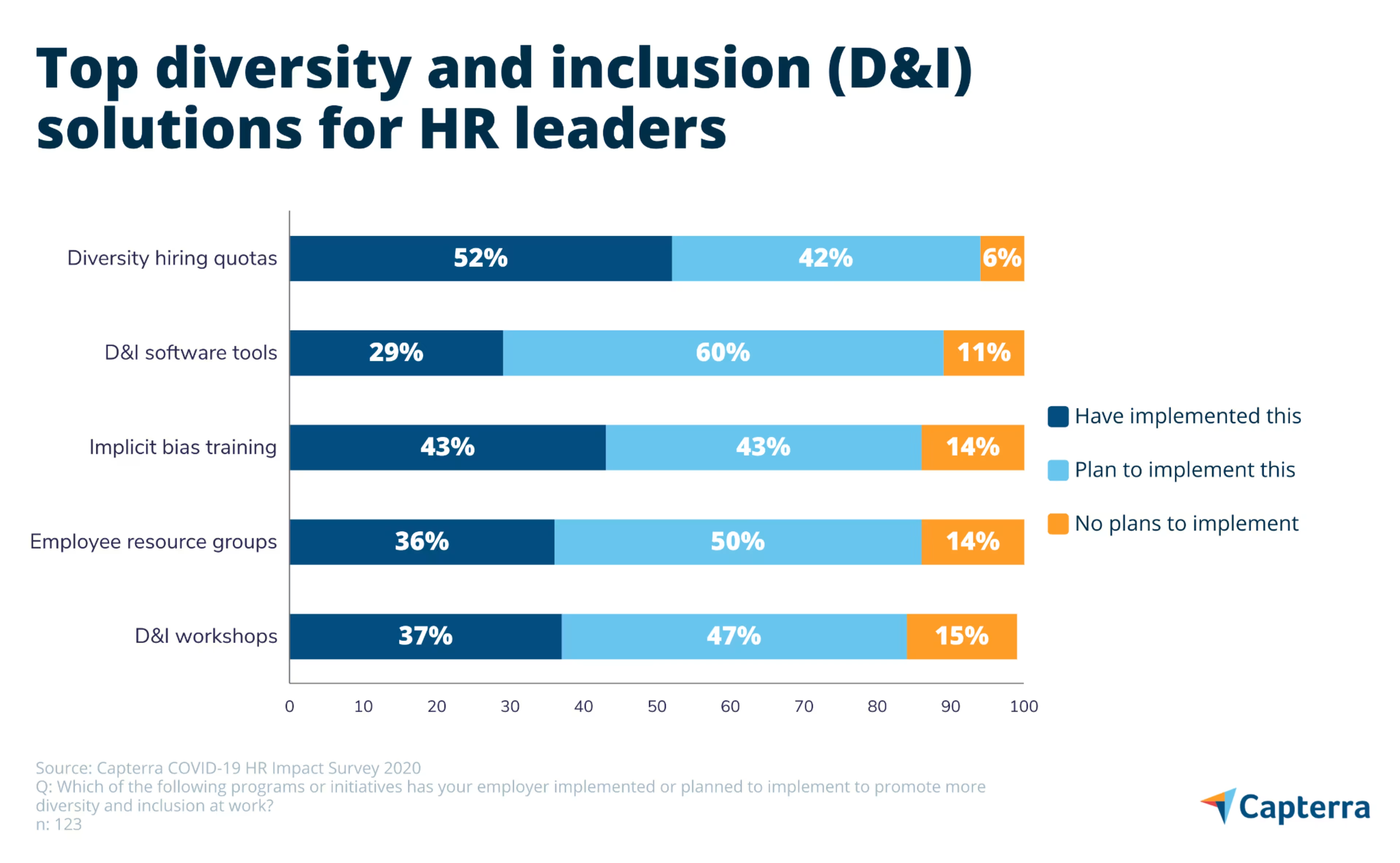We take a look at recent Capterra survey data to analyze three talent management trends HR leaders need to act on today.

If the COVID-19 pandemic has taught us anything, it’s that you can never truly know what’s going to happen next. Case in point: Right before the pandemic began, I made some bold predictions about where talent management was heading in the 2020s. And sure, while there’s still time for many of these predictions to come true, there’s no doubt that the events of the past year have altered their course significantly.
Now that we’re almost halfway through 2021, it’s time to reassess. What does the future of talent management have in store after a once-in-a-century disruption? Can we even be confident in our predictions anymore?
Using Capterra’s own survey data, we’re here to look at three talent management trends that we’re certain every HR leader needs to know about right now. The organizations (of any size) that quickly incorporate these trends into their talent management strategy are going to be the ones best equipped to maintain a productive, engaged workforce for the foreseeable future.
The burden of employee burnout gets dedicated help
Prediction:
By 2030, 30% of companies will have a dedicated chief wellbeing officer to manage employee mental health.
As anyone in HR knows, employee burnout is not a new problem. In 2018, Gallup declared that two-thirds of full-time workers were experiencing burnout on the job, affecting not only their health, but their job performance too.
Every solution under the sun has been proposed to combat burnout, from implementing hard work stops, to encouraging workers to use more PTO, to adding more wellness benefits. According to Gartner, 68% of organizations introduced at least one new wellness benefit by late March 2020 to help employees with burnout at the start of the COVID-19 pandemic.
None of it has helped, and in fact, the burnout problem has only gotten worse. According to Capterra’s HR in the New Era survey* conducted in January 2021, 77% of small business employees in the U.S. who are working from home due to COVID-19 have experienced at least some burnout. For Gen Z workers ages 18 to 25, that number skyrockets to 92%.

Has the pandemic itself played a factor here? Surely. But the fact remains that organizations have a worsening burnout problem on their hands that they need to act on, or watch their best and brightest leave for more accomodating opportunities.
Enter the chief wellbeing officer (CWO)—a role dedicated to employee mental health that first popped up in 2018, but we think will be in nearly one-third of all organizations by 2030.
The reasoning is simple: For every traditional role in the organization, burnout will always be a secondary priority to other business objectives. With no one to focus solely on implementing burnout solutions, marketing them to workers, and monitoring their effectiveness, any ground gained against employee burnout will only be temporary before the company falls back on bad habits.
As part of HR leadership, a CWO is a dedicated resource to address workforce mental health issues, align business units on wellness processes and messaging, and ensure the entire organization stays committed to dealing with the issue long term.
All that to say, if you’re a growing company with a bad burnout problem, a CWO may be the remedy you’re looking for.
Discover other creative ways businesses are tackling burnout with "Employee Wellness Programs: 3 Unique Examples To Inspire SMBs".
Businesses tackle the skills gap head-on
Prediction:
By 2025, 50% of new skills at an organization will be developed internally rather than hired from the outside.
According to a Gartner survey, the top priority for HR leaders in 2021 is to build critical skills and competencies in their employees. When you dive into the sad state of talent development right now, it’s not hard to understand why.
When it comes to recruiting and hiring (the first path most organizations look to in order to bring important skills in-house), companies aren’t finding what they need to succeed long term. Gartner found that only 16% of new hires possess all of the skills they need for both their current and future roles.
Blame ever-advancing skills requirements as organizations build toward the future of work, or the rapidly rising costs of traditional learning paths such as college degrees, but new hires aren’t bringing in as many needed skills as they used to.
Taking a passive role and encouraging internal talent to develop important skills themselves hasn’t worked out either. Almost half (49%) of small business employees in Capterra’s HR in the New Era survey say they haven’t learned any new skills during the COVID-19 pandemic, and only 17% learned new skills on their own.

Like it or not, businesses of all shapes and sizes will need to take a more active role in skills development than they ever have if they want to compete moving forward. Luckily, there are more affordable tools and techniques at their disposal to do so than ever before:
Mentoring software systems can help organizations formalize, digitize, and track mentor-mentee relationships, while social learning platforms give workers tools to develop their own eLearning content—each with the goal of enabling skills transferring from one employee to another.
Microcredentials from organizations such as Udemy and Coursera offer a shorter, more agile, and more affordable path to accreditation than typical college degrees. Managers can assign microcredentials to employees that align with team skills needs and track them through a learning management system (LMS).
Whether they’re writing an email or looking up a lead in a CRM system, learning in the flow of work requires artificial intelligence (AI) and integrations with learning systems to deliver eLearning content to employees at the exact time they need it. This ensures that workers can constantly and consistently learn on the job.
If you’re an HR leader or other HR professional, it’s past time to get together with department managers and company leadership to implement the tools and content your company needs to support continuous learning. Without it, those dreaded skills gaps will only continue to grow.
For more help on finding the right continuous learning software, check out “5 Digital Learning Platforms to Help Close Company Skills Gaps.”
Diversity and inclusion (D&I) finds a friend in technology
Prediction:
By 2023, 90% of organizations will implement software and technology to improve diversity and inclusion outcomes.
After years of talk, workers are increasingly eager to see their employers actually walk the walk on diversity and inclusion (D&I). In Capterra’s COVID-19 HR Impact survey** conducted in August 2020, 46% of HR leaders said they felt more pressure from their workforce to become more diverse and inclusive compared to years prior. Only 8% say they feel less pressure than before.
To improve their D&I situation, companies have been looking to highly-publicized solutions—things such as diversity hiring quotas, implicit bias training, and publishing D&I transparency reports. But they’re also increasingly looking to a new source for help: Technology.
When asked what programs or initiatives they had implemented or were planning to implement to promote diversity and inclusion in their workplace, HR leaders in our survey cited the use of D&I software tools more than any other solution besides hiring quotas.

Purchased as a standalone tool or found as a feature set in a variety of talent acquisition and HR suite solutions, software can improve D&I in a number of ways:
Job description tools can analyze job postings for biased language and suggest alterations that can attract more diverse job seekers
Candidate sourcing tools can crawl publicly-available online data sources (usually social media sites) to find diverse job candidates that meet requirements for a specific role
Candidate assessment tools can have a “blind hiring mode” that redacts identifiable information from applicant profiles so that companies can make more unbiased hiring decisions
HR analytics tools can analyze the data surrounding hiring, performance management, and promotion decisions—including those made for the board of directors—for biases and inequalities
Companies are learning the hard way that D&I takes a concerted effort across talent management teams and processes. These up-and-coming D&I software tools can certainly help too, and with 60% of HR leaders making plans to implement them, we think a large majority of businesses will be using this technology sooner rather than later. Won’t you join them?
To learn more, check out “3 Ways HR Tech Can Improve Diversity & Inclusion in the Workplace.”
Prepare today, benefit tomorrow
HR can feel as though you’re spinning a bunch of plates at the same time and hoping none of them drop. The future of talent management will only intensify that feeling. At the same time that organizations need to put a concerted effort towards eliminating burnout and improving D&I, they also need to pour resources into ensuring their workers have the skills needed to support the company long term.
It can all seem a bit daunting, but don’t panic. First things first: Bookmark Capterra’s talent management blog to stay on top of the latest HR trends and best practices. We’re constantly doing research and publishing helpful articles to help HR leaders just like you.
When you’re in the market for a software upgrade, head to Capterra’s talent management software category page. There, you can read software reviews from real users, compare features and pricing, and find everything you need to make the right software purchase for your business.